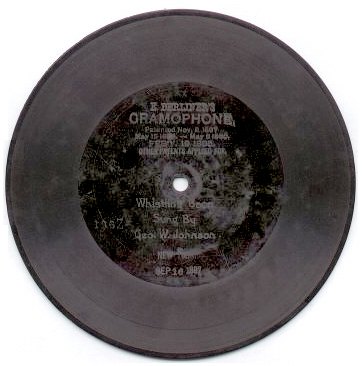As he had done earlier with Bell’s telephone, Berliner began by examining in detail both the phonograph and the graphophone in order to learn the advantages and disadvantages of each. He soon formed the following conclusions: the wax cylinder, while a vast improvement over the tinfoil cylinder, was too soft and fragile for making a permanent recording. … The vertical cut (or hill-and-dale cut) grooves were often not deep enough to keep the stylus from skidding across the surface of the cylinder. … A soft wax cylinder could not be mass-produced, so if recordings were ever to be widely disseminated, some method of mass-producing exact facsimiles was required. All of this added up to the fact that there was a need in the sound recording and reproduction field for a different type of machine, one that did not use soft wax cylinders, one that did not use the vertical-cut groove that was alternately deep with loud sounds and shallow with soft sounds, and one that employed a relatively hard and permanent record that could be easily reproduced in vast numbers. (Read more)

Very early in his work, Berliner decided upon the disc format coupled with the lateral vibration used by Leon Scott in his phonautograph. Scott had developed this machine in the 1850s for the sole purpose of visually recording the vibrations of the voice so that they could be studied by those involved with human speech.
Berliner decided to work with the phonautograph. First he tried to replicate the delicate tracings he had made on blackened glass on a sturdier substance through a photoengraving process.

After trying many different substances, Berliner finally turned to zinc. He would coat a zinc disc, with a beeswax and cold gasoline mixture. Then he cleared away the coating with fine lines made by a stylus attached to a mica diaphragm so that it would vibrate from side to side. Then, after coating the blank reverse side of the disc with varnish, he would immerse the disc in an acid bath. After a certain time, the acid etched the fine lines into grooves in the zinc, leaving the remaining parts of the disc untouched. With the vibrations fixed into the zinc, the disc could be placed on a turntable and the sound reproduced with a steel stylus. Unlike the cylinder machines which could be used for both recording and playback, Berliner’s method required two machines, one for each process. As a name for the whole operation the inventor coined the word “gramophone”. His earliest patents were number 372,786, awarded November 8, 1887, and number 382,790, dated May 15, 1888. Berliner continued to patent improvements to his gramophone throughout the remainder of the century and even into the early years of the twentieth century, by which time he had lost control over his gramophone business. (Read more)
To browse the Library of Congress Emile Berliner and the Birth of the Recording Industry Collection, click here.
Item on display in the Archives
Bellphonic Phonograph No. 11, 1927



